July NBNZ business outlook
I don’t usually write about his, as I don’t actually have access to the historical numbers, but I thought that this time the July Business Outlook was worth a look.
Three main things stick out of it like an eyesore:
- Own activity expectations are down to -8.2%, a bad result. This is mainly to do with a negative outlook for the construction industry.
- Employment and unemployment measures have deteriorated – indicating that the labour market is loosening.
- Pricing intentions and inflation expectations are up.
Now the low own activity expectations imply that the September quarter has not got off to a good start in terms of economic growth – this will be an important measure to keep an eye on going forward.
Most interestingly, the fall seems to be primarily the result of a weaker outlook for the construction industry and NOT retail. This is a touch surprising, especially given the 16% increase in retail fuel prices over the three months to July.













